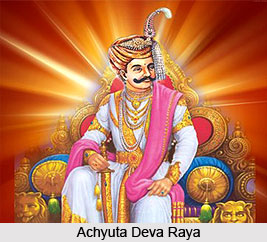 Achyuta Deva Raya ruled the region of Vijayanagara in the southern portion of India between the time period from 1529 to 1542 CE. He was Krishna Deva Raya`s younger brother and ascended the throne in 1529, following the death of Krishna Deva Raya. Chatu Vittalanatha, a Kannada poet was patronised by Achyuta Deva Raya. Rajanatha Dindima II, a famous Sanskrit scholar and Purandaradasa, a composer were amongst the other reputed personalities who were encouraged by this ruler. After the death of Achyuta Deva Raya, Sadasiva Raya, who was his nephew succeeded him to the throne. Since Sadasiva Raya was quite young to be a king, Aliya Rama Raya, who was Krishna Deva Raya`s son-in-law acted as his regent.
Achyuta Deva Raya ruled the region of Vijayanagara in the southern portion of India between the time period from 1529 to 1542 CE. He was Krishna Deva Raya`s younger brother and ascended the throne in 1529, following the death of Krishna Deva Raya. Chatu Vittalanatha, a Kannada poet was patronised by Achyuta Deva Raya. Rajanatha Dindima II, a famous Sanskrit scholar and Purandaradasa, a composer were amongst the other reputed personalities who were encouraged by this ruler. After the death of Achyuta Deva Raya, Sadasiva Raya, who was his nephew succeeded him to the throne. Since Sadasiva Raya was quite young to be a king, Aliya Rama Raya, who was Krishna Deva Raya`s son-in-law acted as his regent.
Rule of Achyuta Deva Raya
The regime of Achyuta Deva Raya witnessed political unrest and struggle for power. Rivals of the Vijayanagara Empire made numerous attempts to plot the downfall of the kingdom, including Aliya Rama Raya, who was secretly conspiring against Achyuta Deva Raya in order to win the throne. As per the records of history, this young ruler was pious and bravely fought many wars in order to restore peace and prosperity to Vijayanagara. It is believed that Krishna Deva Raya had himself chosen Achyuta Deva Raya as his successor as he displayed the signs of being a capable king.
The area around Raichur Doab was invaded by Isamail Adil Shah of Bijapur. But, Achyuta Deva Raya`s army was able to defeat Quli Qutb Shah of Golconda and Gajapatis of Orissa. Thereafter, Achyuta Deva Raya accompanied Salakaraju Tirumala, who was his general, and aimed to bring the chiefs of Ummattur and Travancore under his supervision. This was achieved without much ado. The region of Doab, which is located near the northern portion of Tungabhadra were brought under control and the forts of Mudgal and Raichur were captured again, by the army of Achyuta Deva Raya. When Achyuta Raya ruled Vijayanagara, the Tiruvengalanatha Temple had been constructed and it was referred to as the Achyutaraya Temple. Lord Venkateshwara was the presiding deity of this ancient temple.
`Varadambikaparinayam` and `Achyutabhyudayam` are the two major Sanskrit works which contain elaborate details concerning the life and reign of Achyuta Deva Raya. During his rule, Achyuta Deva Raya had to deal with the overambitious Aliya Raya Raya, his regent who made every attempt to usurp his throne. The Bahmani Sultans had to be summoned quite frequently to solve the disputes between Achyuta Deva Raya and Aliya Rama Raya. Finally in the year 1540, Achyuta Raya was imprisoned by his regent in a coup and he died in 1542. During 1542, after the death of Achyuta Deva Raya, his young son Venkatadri Raya or Venkata I ascended the throne, though he was killed very soon. Sadasiva was made the new king, though the real power lay in the hands of Aliya Rama Raya, who as his regent.



















